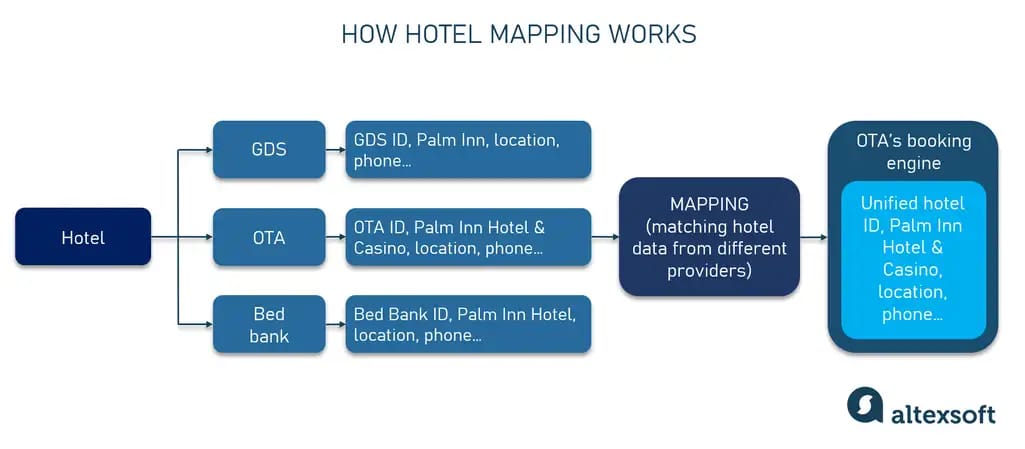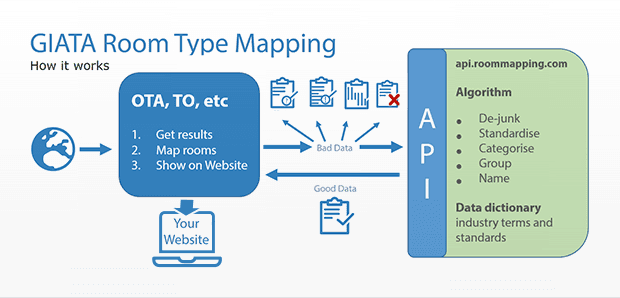“I am wondering if others have experienced what I am seeing,” writes a TripAdvisor user. “When I put in the hotel name in Google maps, I see one location. However, when I put in the street address, I see a different location, generally not as favorable! Locations on Booking.com and Ctrip are also similarly inconsistent with street address. This is not so for every hotel, but I am not sure if some hotels aren’t somehow gaming the system.”
No, hotels and OTAs are not fooling anybody, at least not on purpose. This common problem of inconsistent listings is one that many providers are actually trying to handle. Because the hospitality distribution market is so large and complex, quite often, data isn’t displayed the same everywhere. The technology that helps solve this issue is called hotel, distribution, or content mapping.
What are hotel and room mapping?
Hotel mapping is merging property IDs from different sources into a single property record to avoid inconsistent naming and duplication in listings. Duplications and inconsistent listings happen when an OTA or travel agency sources information from two or more channels, like bed banks, channel managers, GDSs, and larger OTAs.
How does it work? For example, Hotelbeds and Booking.com may have different IDs and naming conventions for the properties they push to distributors. The same hotel can be called, say, Palm Inn in Hotelbeds and Palm Inn Hotel & Casino in Booking.com. Hotel mapping services will normally sift through a set of static attributes such as policies, reviews, ratings, and geolocation to find identical properties and merge (or map) them under a single ID. It also may involve fixing mistakes and improving the quality of inventory data.

Hotel mapping matches data from different sources and merges the entries from different suppliers under a unified ID.
Generally, hotel mapping refers to handling such details as:
- property name,
- contact information,
- address,
- ZIP code,
- descriptions,
- Geo-location,
- policies, etc.
Hotel mapping software helps you regain that control and unify the content, improving the quality and accuracy of the data you present and, ultimately, customer satisfaction. If prices suggested by multiple suppliers differ, it also allows an OTA to choose the best rate and secure more bookings.
Room mapping
While hotel mapping is a more general concept, some software providers also offer room mapping as a separate module.
Like hotel-level inconsistencies, sourcing from multiple suppliers may have room-level inconsistencies. For instance, the same room may be called a “Deluxe Double,” “Luxury,” or “Exclusive.”
So room mapping addresses the issue of duplication the inventory-related content, such as:
- room type,
- room name,
- view,
- amenities,
- bed type, etc.
Room mapping solutions follow the same logic as hotel mapping systems do. They analyze the room data, standardize it, and remove repetitions and unnecessary details, allowing for increased clarity and customer experience.
Why hotel mapping and quality of inventory data matter
As mentioned, there are several important reasons why OTAs and DMCs must consider hotel and room mapping if they source inventory from multiple suppliers.
User experience. Travelers may see duplicating hotels or rooms during search and booking. While this isn’t critical in and of itself, the quality of content sourced from different suppliers may vary. Lacking or poor descriptions and images harm user experience and damage trust. So, it’s better to have a single source of truth and choose the best and most up-to-date content to display.
According to Valeriia Borshch, Head of Marketing GIATA GmbH, “Twenty years of GIATA statistics confirm that about 2 percent of all hotels have major changes every year, either in their name, the chain they are associated with, or their telephone number.” Mapping helps catch these changes and keeps hotel inventory data current.
Look-to-book ratio and margins. The same room sourced from different suppliers will likely have different rates since suppliers partner with hotels on individual terms. Quality mapping will allow you to choose lower rates to increase conversion and prioritize those offers that suggest higher margins.
Cost of mapping errors. Besides mapping being necessary, mapping data quality is no less critical. Valeriia shares, that the average hotel mapping error in Germany can lead to about €1,500 ($1,600) of additional expenses for an OTA. With an average tour price of €2,700, an OTA will have to spend around 55 percent of this figure to cancel the wrong hotel (or pay for it if the hotel declines to refund), book the right one, pay for the transfer, and cover operational expenses. For this reason, mapping providers claim to achieve 99.99 to 99.999 percent of mapping accuracy. Eventually, every mapping error damages a company’s P&L and reputation.
Let’s take a closer look at how exactly content mapping technology works.
How to integrate hotel content mapping?
Most providers have one or both of the two available offers.
Mapping as a service. This is an online tool that uses a simple UI. You upload hotel inventory files and wait for the results. Mapping usually happens automatically, rarely with human intervention. After the mapping is complete, you can download a mapped inventory file. If you’re a distributor, you can invite your partners to upload their inventories to map them on your behalf.
APIs. There’s a more integrated way to do this. If your technical capabilities allow, you can connect your inventory via an API. The mapping service can consistently update information without sending new files repeatedly, which is particularly useful for dynamic content like pricing. Of course, you’ll need engineers to integrate the API. If content mapping is part of a booking engine or any other product, it usually updates content automatically.
Our main goal with this article is to show you how different providers work, compare them, and explain their integration methods. Keep reading for the help you need to make the right choice.
Hotel mapping providers and tools
Most mapping tools exist as a module in general-purpose software, like back office systems and booking engines. Today most mapping solutions are AI-powered – some use extra manual data processing or don’t use it at all. Manual checks help eliminate mistakes or complete mapping where ML models fall short.
You should also consider personalized features. The solution providers can even interpret the mapping process differently: Some give access to their property databases and allow for exporting the files with IDs to match them later, while others automatically map existing OTA’s inventory with properties coming from different suppliers (GDSs, bed banks, etc.)
GIATA: The largest hotel database with automated and manual mapping
GIATA is a Berlin-based provider that has been operating since 1996. GIATA is the market leader in hotel mapping containing a hotel directory of around 1.2 million properties and 124 million booking codes. Today, the universal property codes – GIATA MultiCodes -- are industry standard, which allows different players across the travel distribution ecosystem to use the same ID system to exchange information without extra mapping effort.
GIATA provides mapping services for hotels, metasearch engines (In 2018, Google became GIATA’s client), online travel agencies (TripAdvisor), bed banks (Hotelbeds and MTS Globe), GDSs (Amadeus and Sabre), and tour operators (TUI and DER Touristik). Since 2022, MultiCodes are also available across such software systems as TravelgateX, Qtech, WBE, ANIXE, Qenner, Juniper, TCT, Ahead, Paximum, and more.
GIATA combines both automated and manual mapping. The solution uses AI technologies that involve fuzzy logic, a grading-based machine learning approach. Those properties that, for various reasons, can’t be processed automatically undergo manual checks to achieve higher mapping quality. As processed, a property gets a default GIATA MultiCode, the property’s unique ID matched to the supplier’s property codes.
GIATA hotel ID provides the following information about a property via REST API:
- Location (address, city, country)
- Contact information (email, phone, fax)
- Hotel website URL
- Longitude/latitude
- Geocode
- Booking code
- GDS/CRS code
- Chain affiliation
- Official star and recommended ratings
- Near airports
- Link to content in other languages
The information updates regularly as any mapping error or change in details (e.g., hotel name, hotel chain affiliation) are sent to GIATA. The company updates the data across the entire network of partners.
You must use separate GIATA solutions and APIs to map more data types. Let’s take a look at them.
Room Type Mapping. GIATA has a separate solution for dynamic room mapping, powered by an algorithm underpinned by a dictionary. It’s updated as new room names are discovered, focusing on the elements of room description and ignoring rate modifiers, like boarding type or cancellation terms. As a result, the clients can integrate the output into their existing search process to display the best pricing across multiple suppliers for a comprehensive set of room options.
You can access room mapping via an API where supplier room names are categorized, grouped, and standardized using the key attributes, such as:
- Room type
- Class
- View
- Room features (e.g. Balcony)
- Bed Type
- Number of bedrooms and specific room types
Also, such elements as accessibility, shared facilities, and annex are flagged.

GIATA room type mapping process
GIATA Room Type Mapping (RTM) can either be used dynamically as part of a live search and booking or to assist in building an internal room type cache/database. Also, the solution uses natural language processing in multiple languages, including English, German, Spanish, French, and others.
Content integration. GIATA has an additional Internet Hotel Guide solution that standardizes hotel descriptions in multiple languages, integrates photos and videos, and provides holiday offers.
Multilingual Hotel Guide. GIATA has a separate online solution for processing standardized hotel descriptions in 25 languages via XML API. Plus, it offers property factsheets in 42 languages and related photos.
GIATA claims to have 99.998 percent mapping accuracy.
Mapping.Works by Gimmonix: Mapped inventory in under 24 hours
Gimmonix is a travel technology company that provides fully automated cloud-based solutions that largely focus on data accuracy, with Mapping.Works being the technology developed for hotel mapping. As Gimmonix claims, it takes only 24 hours to process listings data, and no manual labor is used. Currently, they have 1.9 million properties in their database.
Currently, Mapping.Works offers hotel and room level mapping.
Hotel mapping is a solution for suppliers and OTAs. It’savailable as an API integration or as a GUI with a drag-and-drop interface where you can upload a file with hotel data to be processed automatically via FTP protocol. Also, the tool has an analytic module that provides insights into bestselling inventories.
Room mapping is available via an API. A premium API service checks hotel room content with special or unusual names. The mapped property contains eight attributes, but you can extend the number for an additional price. The room mapping API of Mapping.Works unifies data on:
- Room types name
- Class
- Amenities
- Beds
- View
- Policy

Room level mapping, visualized. Source: Mapping.Works
DataBindR: The most detailed room-level mapping with spell check
DataBindR is a cloud mapping provider that uses machine learning and natural language processing. They offer three solutions for hotel data mapping.
HotelMappR allows businesses to map different inventory catalogs. A user must upload thier hotel catalog as a CSV/Excel file and get a file with mapped information ready for integration.
HotelBindr and RoomBindR are hotel and room mapping services available via a REST API. The hotel-level API processes key information about the hotel, creating its portfolio in several languages if needed. This information includes:
- Country ID
- Hotel name
- Hotel address and town
- Hotel category
- Hotel ZIP code
- Longitude and latitude
The system processes the data using deep learning. And based on this information, it assigns a hotel BindID. Room and hotel information gets mapped via another API.
RoomMappR maps the following hotel room information and assigns it a unique BindID code:
- Room ID
- Description
- Policy (conditions)
- Detailed room description
- Room type
- Capacity and size
- Gender (for mixed rooms)
- Environment (shared/communicated bathroom)
- Bathrooms
- Room category (deluxe, premium, standard)
- Views (city, sea, pool)
- Preferences (smoking, pets, etc.)
- Amenities
- Dormitories
- Beds, bunks, extra beds
Later, their system matches rooms to the hotel portfolio. DataBindR claims to correct syntactic errors via algorithms targeting hospitality businesses. They don’t use manual processing.
The clients can reuse these codes later, even when they stop using the solution. The system checks and cleans the data itself.
Juniper Unique Hotel: An integrated booking engine solution with mapping opportunities
Juniper is a travel solutions provider from Spain that offers services for OTAs, hotels, DMCs, and wholesalers alike. Its mapping tool is a module of its booking engine, Juniper Unique Hotel. It standardizes the list of hotels and rooms, allowing you to arrange it by price or supplier. The booking engine links to the source database via XML and maps the content. Juniper Booking Engine connects to over 300 suppliers.
Juniper Unique Hotel maps visual content and hotel and room information by the following categories:
- Bed type
- Board type
- Rooms
- Prices
- View
- Bathroom
- Policy
- Mealplan
The offers are automatically sorted from the cheapest to the most expensive, adding automated search for the prices in the database.
Trawex Hotel Mapping Solution: Full database maintenance
Online booking software provider Trawex has B2B and B2C solutions for hotel mapping. They connect not only to hotels and GDSs but also to vehicle rental services.
Trawex Hotel Mapping software performs accommodation and destination mapping. The hotel mapping module handles all necessary hotel details:
- Address
- Description
- Logos and photos
- Geocode
- Hotel category
- Prices
Trawex also has a destination mapping feature that standardizes location mapping assigning a separate ID for city, country, and region. Their mapping solution takes into account different spellings for some locations. One of the advantages of the Trawex product is that they provide full maintenance of the database update.
dcs plus: Separate IDs for hotels and destinations
dcs plus, a Romanian travel and tourism technology solutions provider, offers hotel content mapping services integrated with their Travel Booking System IRIX and automatically exporting data for their users. Non-IRIX clients can export a mapping archive in an XML file. Content mapping assigns separate IDs to hotels and covers the following hotel categories:
- Addresses
- Geocodes
- IATA codes
- Countries, regions, and states
- Star rating
Also, dcs plus has a destination mapping feature. The mapped content can be sorted by price, rating, or other criteria. The service works on machine learning algorithms and involves additional manual data checks afterwards.
Vervotech Mapping: Fast-growing mapping and content management technology
Vervotech is another SaaS provider of hotel mapping services that uses automated ML algorithms and claims to map content with 99.999 percent accuracy. It was established in 2018 but is already working with over 2 million hotels and 1 million apartments across more than 600 suppliers. The provider supports both a web version and API connectivity. The tool operates such details as:
- Name
- Address
- City
- Postal/Zip code
- Country Code/Country Name
- Images
- Amenities
- Contact information
- Geolocation services/Geo-codes
- Real-time rates and subsequent availability
As you can see, Vervotech deals not only with general hotel details but also with images, amenities, ratings, etc. Besides, it analyzes the content quality and notifies if some information is missing or invalid.
The data updates occur multiple times daily, so Vervotech offers real-time content. It also comes pre-integrated with all the leading inventory suppliers.
The Room Mapping module is available as part of the Hotel Mapping software or as a standalone solution with a claimed accuracy of 95 percent. It supports multilingual content.
Hotel mapping: Where to start?
That said, let’s discuss the first steps to integrating a mapping system into your workflow.
Check whether your suppliers categorize hotel data differently. If this problem exists, decide which challenge you want to solve. If you’re looking forward to enhancing an existing booking engine, consider tools with larger databases, like GIATA and Gimmonix. In case you’ve just started choosing an integrated system, finding a booking engine with inbuilt mapping functionality makes sense.
Consider necessary features. The hotel mapping market is patchy and unsystematic, and you’ll face the problem of choice in the first place. These solutions may seem similar at first glance, and indeed, they all use almost the same approaches in hotel mapping. What differs is the quality of mapping and the actual sizes of supplier networks. Also, look at the tools that provide multilingual mapping if you need hotel profiles in multiple languages.
Find out whether you need API integration. Although most solutions have a drag-and-drop feature, an API would be better for dynamic data. Contact your provider to learn if they assist with integrating their service. If they don’t offer such support and you don’t have the technical capacity to integrate an API, find a travel tech service company to help you out.

